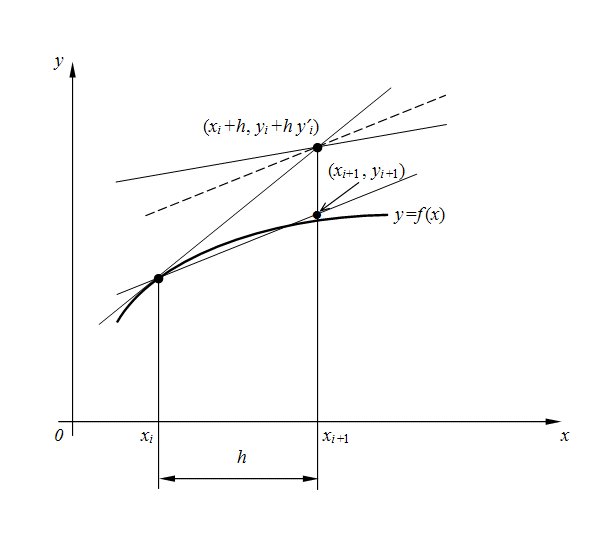|
Ordinary differential equations - Euler's method
Euler's method
Let's consider the differential equation
 (1)
(1)
with an initial condition

Substituting
 into the equation (1), we’ll receive value of a derivative in a point
into the equation (1), we’ll receive value of a derivative in a point
 :
:

At small
 the following expression takes place:
the following expression takes place:

Designating
 , let’s rewrite the last equality in the form of:
, let’s rewrite the last equality in the form of:
 (2)
(2)
Accepting now
 for a new initial point, precisely also we’ll receive
for a new initial point, precisely also we’ll receive

In the general case we’ll have:
 (3)
(3)
It also is
Euler's method
. The value
 refers to as
step of integration
. Using this method, we receive the approached values
у
, at as the derivative
refers to as
step of integration
. Using this method, we receive the approached values
у
, at as the derivative
 actually does not remain to a constant on an interval in length
actually does not remain to a constant on an interval in length
 . Therefore we receive a mistake in definition of value of function
у
, that greater, than
. Therefore we receive a mistake in definition of value of function
у
, that greater, than
 is more. Euler's method is the elementary method of numerical integration of differential equations and systems. Its defects are a small accuracy and a regular accumulation of mistakes.
is more. Euler's method is the elementary method of numerical integration of differential equations and systems. Its defects are a small accuracy and a regular accumulation of mistakes.
More exact is
Euler's modified method with recalculation
. Its essence that at the first we find from the formula (3) so-called «a gross approach» (prediction):

and then the recalculation
 gives
us
too approached, but more exact value (correction):
gives
us
too approached, but more exact value (correction):
 (4)
(4)
Actually the recalculation allows to consider, though approximately, a change of a derivative
 on a step of integration
on a step of integration
 as its values in the beginning
as its values in the beginning
 and in the end
and in the end
 of a step (Fig. 1) are considered, and then their average is chosen. Euler's method with recalculation (4) is in essence the 2-nd order Runge-Kutta method [2]. This will become obvious of the further.
of a step (Fig. 1) are considered, and then their average is chosen. Euler's method with recalculation (4) is in essence the 2-nd order Runge-Kutta method [2]. This will become obvious of the further.

Fig. 1. The geometric representation of Euler’s method with recalculation.
|

